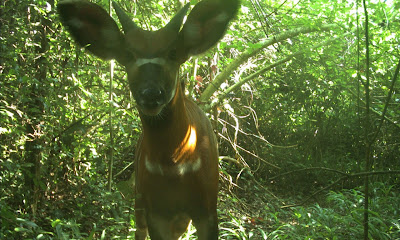Remote cameras offer glimpse into the 'forgotten forests' of South Sudan
by Sarah Rakowski, Fauna & Flora International
Dated 09 December 2015
Photo: Camera trapping survey captures newest country's first photographic records of forest elephants, African golden cat and more…
Remote sensing cameras ('camera traps') have given scientists an unprecedented insight into the wildlife of South Sudan—a battle-scarred nation still grappling with civil conflict following its declaration of independence four years ago.
The cameras were deployed as part of ongoing surveys under a partnership between conservation charity Fauna & Flora International (FFI), Bucknell University, and South Sudan's Wildlife Service to survey the wildlife of Western Equatoria State—an area that encompasses some 8,000 km2 of relatively unexplored terrain thought to be of high ecological importance.
The camera trapping survey was made possible thanks to a grant from the U.S. Fish and Wildlife Service's Great Ape Conservation Fund, with additional funding from the Woodtiger Fund, Bucknell University and FFI.
Over six months, the camera traps captured more than 20,000 wildlife images, including the first pictures of forest elephants (Loxodonta cyclotis) ever taken in South Sudan.
"This is an extremely important finding," explains DeeAnn Reeder, Professor of Biology at Bucknell University. "Forest elephants are Critically Endangered, and have declined dramatically over the last two decades.
Finding them in South Sudan expands their known range—something that urgently needs further study because forest elephants, like their savannah cousins, are facing intense poaching pressure."
Forest elephants are ecologically and behaviourally quite distinct from savannah elephants and play an important role in forest ecosystems by dispersing seeds across a wide area, thanks to their frugivorous diet.
Photo: Forest elephant family. Credit: FFI & Bucknell University.
The cameras also found a number of other species never before recorded in South Sudan (or in pre-independence records) including the African golden cat, water chevrotain, red river hog and giant pangolin.
Chimpanzee, leopard, four species of mongoose, spotted hyena, yellow-backed duiker, honey badger, monitor lizard and a healthy population of western bongo are just a few among 37 species caught on camera during the survey, proving the ecological importance of these West Equatorian forests.
"Camera trap surveys play a fundamental role in biodiversity conservation," says FFI's Adrian Garside.
"First, they provide information about the distribution, movements and behaviour of wildlife found within an area, giving us a baseline upon which we can measure changes and success. Second, and just as important, they offer clues as to where we need to focus our efforts, and they can even identify potential threats."
Conservation in times of conflict
FFI has been working in South Sudan since 2010 (in the run up to the country's formal declaration of independence) and first partnered with Reeder, an African mammal biodiversity specialist, in Western Equatoria in 2012. With substantial experience of operating in fragile and conflict States, FFI's focus has been on ensuring that South Sudan's remarkable natural ecosystems and wildlife could be effectively conserved from the outset of the country's independence.
To do this, FFI is helping to find pragmatic, community-focused solutions to environmental threats, while also ensuring that local authorities and stakeholders have the skills and equipment they need to manage their natural resources sustainably.
Photo: Golden cat walking on human trail. Credit: FFI & Bucknell University
As part of this mission to develop local capacity, Garside and Reeder ran a camera trap training exercise for rangers from the Ministry for Wildlife Conservation and Tourism and local Community Wildlife Ambassadors. During the last four years, local knowledge provided by people living in the area has helped the team find evidence of significant wildlife, and this local expertise also proved critical in the successful situating of the cameras. Joint patrols by the wildlife and community rangers continue to monitor the cameras and conduct data analysis.
But despite the successes of the survey, great challenges remain says Garside.
"The violence in South Sudan and the spectre of economic collapse is a challenging situation for conservationists, but we had established strong partnerships here before the current conflict and we are all determined to continue working together through this difficult period. To date, this support has included ranger training and biodiversity monitoring as well as numerous foot patrols to monitor wildlife and deter illegal activity.
Photo: Wildlife Ranger and Community Wildlife Ambassador setting camera traps. Credit: FFI & Bucknell University
"Experience has shown that wildlife and ecosystems often suffer enormously during and after conflict, and in periods of political instability, and this depletion of natural resources affects some of the poorest and most vulnerable sectors of society," says Garside.
"By maintaining our presence in-country, building good relationships with local communities and supporting our partners, we will find ourselves in a far better position to help people manage their resources sustainably, both now and in the future."
Explore further








